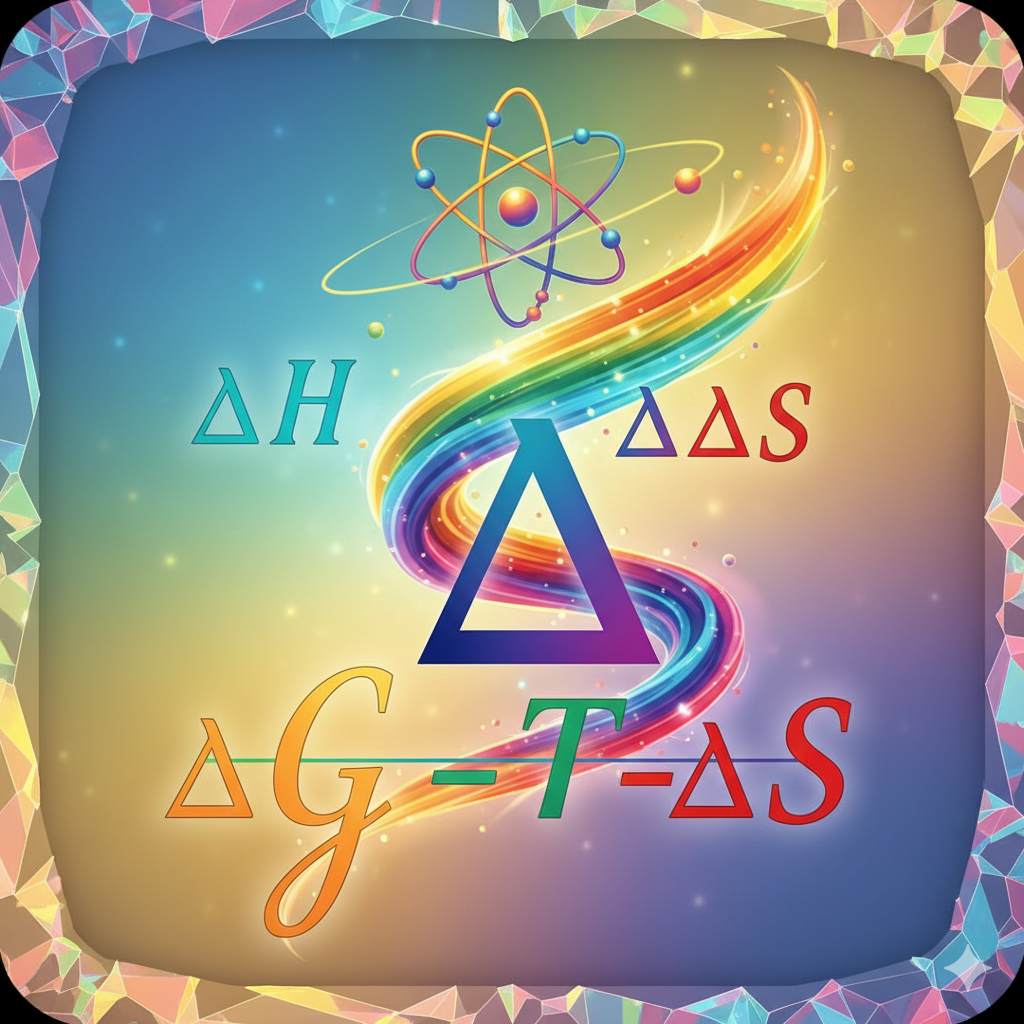Gibbs Free Energy
Calculate Gibbs Free Energy (ΔG) easily. Determine spontaneity of reactions with our free online tool. Enter enthalpy, entropy, and temperature.
The Gibbs Free Energy Calculator Tool 🧪✨ is a precise, chemistry-focused utility designed to help you calculate Gibbs Free Energy (ΔG) and determine whether a reaction is spontaneous, non-spontaneous, or at equilibrium under specific temperature and energy conditions.
Built for students, chemists, researchers, and educators, this tool automates the core thermodynamic equation — turning complex entropy and enthalpy relationships into clear, instant results you can understand and apply in real experiments.
⚙️ Key Features:
⚛️ Instant Gibbs Free Energy Calculation:
Enter enthalpy change (ΔH) and entropy change (ΔS), along with temperature (T in Kelvin), to instantly compute ΔG using the standard Gibbs equation.🧮 Supports All Unit Systems:
ΔH: kJ/mol, J/mol, or cal/mol
ΔS: J/mol·K or cal/mol·K
T: Kelvin or °C (auto-converts to Kelvin internally)
🔢 Automatic Unit Conversion:
Converts all entered units for consistent, error-free calculations.📊 Reaction Spontaneity Indicator:
Displays results clearly as:✅ Spontaneous (ΔG < 0)
⚠️ Non-Spontaneous (ΔG > 0)
⚖️ At Equilibrium (ΔG = 0)
🔥 Standard Conditions Mode (ΔG°):
Calculates standard Gibbs energy change at 298 K (25°C) by default, with easy customization for other temperatures.🧫 Advanced Equation Integration:
Includes ΔG = ΔG° + RT ln(Q) for non-standard conditions, enabling real-world equilibrium and concentration-based computations.⚗️ Step-by-Step Solution Display:
Shows all intermediate steps for educational clarity:📈 Thermodynamic Visualization:
Optional chart display of ΔG vs Temperature (T) to visualize when a reaction becomes spontaneous.🌡️ Temperature Sensitivity Mode:
Automatically identifies the critical temperature at which ΔG = 0 (transition between spontaneity and non-spontaneity).🧾 Multi-Reaction Mode:
Compare Gibbs energies of multiple reactions side-by-side for reaction selection or process optimization.📱 Responsive Design:
Works seamlessly across desktop, mobile, and tablet — ideal for lab or classroom use.
💡 How It Works (Simplified):
The Gibbs Free Energy equation combines enthalpy (ΔH) and entropy (ΔS) changes to determine whether a chemical process will occur spontaneously:
🧮 Formula:
Where:
ΔG = Gibbs free energy change (kJ/mol or J/mol)
ΔH = Enthalpy change (heat content)
T = Temperature in Kelvin (K)
ΔS = Entropy change (disorder)
📘 Example Calculation:
Given:
ΔH = –150 kJ/mol
ΔS = –200 J/mol·K = –0.200 kJ/mol·K
T = 298 K
Solution:
✅ Result: The reaction is spontaneous (ΔG < 0).
🧪 Advanced Formula (Non-Standard Conditions):
Where:
R = 8.314 J/mol·K (gas constant)
T = Temperature (K)
Q = Reaction quotient
This allows calculation of Gibbs energy under non-equilibrium conditions, integrating thermodynamic data with real-world concentrations.
🧭 Perfect For:
🧠 Students & Educators: Understand and teach spontaneity, enthalpy, and entropy relationships.
🧪 Chemists & Researchers: Analyze reaction feasibility in labs or chemical engineering setups.
⚗️ Industrial Scientists: Optimize chemical process temperatures for maximum efficiency.
🔬 Biochemists: Calculate ΔG for metabolic or enzyme-catalyzed reactions.
📚 Thermodynamics Learners: Visualize how temperature affects Gibbs energy and equilibrium.
🔍 Why It’s Valuable:
The Gibbs Free Energy Calculator Tool bridges theory and practice by providing accurate thermodynamic insights instantly — no manual math required.
It helps users:
✅ Predict whether reactions occur spontaneously.
✅ Understand temperature influence on reaction feasibility.
✅ Compare reaction energetics for experimental planning.
✅ Reinforce learning through real-time feedback and visualization.
It’s not just a calculator — it’s your digital thermodynamics assistant, simplifying energy-based decision-making in chemistry and physics.
🧩 Advanced Options (Optional):
🌡️ Temperature Range Simulation: Automatically plot ΔG over 0–1000 K.
⚗️ Reaction Comparison Mode: Evaluate Gibbs energies for multiple reactions simultaneously.
🧾 ΔG° Table Integration: Access standard Gibbs energy values for common compounds.
📈 Energy Diagram Generator: Create visual energy profiles for exergonic and endergonic reactions.
🧮 Concentration-Based ΔG Adjustment: Compute ΔG using activity or partial pressure data.
🌍 Example Use Cases:
| Reaction Type | ΔH (kJ/mol) | ΔS (J/mol·K) | ΔG at 298K (kJ/mol) | Result |
|---|---|---|---|---|
| Combustion (Exothermic) | –890 | +200 | –949.6 | ✅ Spontaneous |
| Endothermic Reaction | +250 | +500 | +101 | ⚠️ Non-Spontaneous |
| Equilibrium Process | +100 | +335.6 | 0 | ⚖️ Equilibrium |
| Photosynthesis | +2800 | +180 | +2746 | ⚠️ Non-Spontaneous (requires sunlight) |
⚗️ Scientific Insight:
The sign of ΔG is the ultimate predictor of reaction behavior:
ΔG < 0: Reaction is spontaneous (energy-releasing).
ΔG = 0: Reaction is at equilibrium.
ΔG > 0: Reaction is non-spontaneous (requires energy input).
This simple relationship governs all chemical, biological, and physical transformations — from battery operation to protein folding.
✨ In Short:
The Gibbs Free Energy Calculator Tool ⚛️📊 transforms complex thermodynamic equations into clear, visual, and accurate insights. Whether for classroom learning or industrial chemistry, it’s your one-stop tool to analyze reaction spontaneity, temperature effects, and energy efficiency.
Calculate. Predict. Understand.
With the Gibbs Free Energy Calculator, thermodynamics becomes visual, intuitive, and precise. 🔥⚗️🧮






